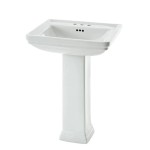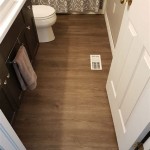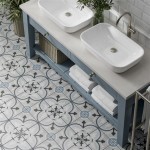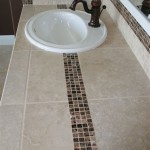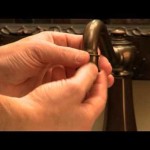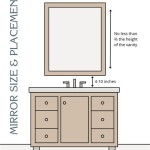What Size Should The Bathroom Mirror Be?
Determining the appropriate size for a bathroom mirror is a crucial aspect of bathroom design that influences both functionality and aesthetics. A well-chosen mirror can enhance the room's perceived size, improve lighting, and contribute significantly to the overall style. However, size selection is not arbitrary; it requires careful consideration of various factors, including vanity size, ceiling height, the room's dimensions, and personal preferences. Improperly sized mirrors can lead to visual imbalances, diminished functionality, and a less satisfying bathroom experience.
The goal is to select a mirror that is both practical for daily tasks, such as grooming and applying makeup, and visually harmonious with the surrounding elements. This involves evaluating existing fixtures and architectural features to ensure the mirror complements the space rather than overwhelms or underwhelms it. A systematic approach to measuring, planning, and considering design principles is essential for achieving an optimal outcome.
Matching the Mirror to the Vanity Size
The most common and generally recommended approach to determining bathroom mirror size is to relate it directly to the vanity. Ideally, the mirror should be approximately the same width as the vanity, or slightly narrower. This proportionality avoids visual imbalance and creates a cohesive look. If the vanity is 36 inches wide, a mirror between 30 and 36 inches wide would typically be a suitable choice. A slightly narrower mirror, such as 30 inches, can offer a more understated and elegant appearance, while a mirror that matches the vanity's width creates a more substantial and impactful presence.
In situations where a double vanity is present, there are a few options. One approach is to install a single, large mirror spanning the entire width of the double vanity. This provides a unified look and maximizes the reflective surface. Alternatively, two separate mirrors can be installed, one above each sink. If opting for two separate mirrors, ensure they are of equal size and symmetrically positioned to maintain visual harmony. The width of each mirror should correspond roughly to the width of each sink or slightly narrower, mirroring the principle applied to single vanities.
When selecting the height of the mirror, it's important to consider the occupants’ heights. The bottom edge of the mirror should be positioned a few inches above the backsplash, typically around 4 to 8 inches, to prevent water damage and create a clean transition. The top edge should be high enough to comfortably accommodate the tallest user. A general guideline is to ensure that the center of the mirror is at eye level for the primary users of the bathroom. In bathrooms used by children or individuals with significant height differences, consider adjusting the height accordingly or opting for larger mirrors that accommodate a wider range of viewing angles.
The shape of the mirror also plays a role in its perceived size and impact. Rectangular mirrors are a classic and versatile choice that works well in most bathrooms. Round or oval mirrors can soften the lines of a more angular space and create a more contemporary or eclectic look. Irregularly shaped mirrors can add a unique and artistic touch but require careful consideration to ensure they are both functional and aesthetically pleasing. When selecting the shape, consider how it relates to the other elements in the bathroom, such as the shape of the vanity, the lighting fixtures, and the overall architectural style.
Considering the Room's Dimensions and Ceiling Height
Beyond the vanity size, the overall dimensions of the bathroom and its ceiling height are vital factors in determining the appropriate mirror size. In smaller bathrooms, a large mirror can create the illusion of more space by reflecting light and expanding the perceived boundaries of the room. Conversely, in larger bathrooms, a smaller mirror might get lost and appear disproportionate. Therefore, choosing a mirror size that complements the room's scale is essential.
High ceilings offer an opportunity to install taller mirrors, which can further enhance the sense of spaciousness and grandeur. A floor-to-ceiling mirror along one wall can be particularly effective in smaller bathrooms, creating a dramatic and expansive effect. However, ensure that such a large mirror does not reflect undesirable views, such as an unsightly toilet or a cluttered corner. Instead, focus on reflecting natural light or aesthetically pleasing elements of the room.
Lower ceilings, on the other hand, may necessitate a shorter mirror to avoid visually compressing the space. In such scenarios, consider horizontal mirrors, which can visually widen the room and create a more balanced impression. Additionally, strategically placed lighting can further enhance the effect of the mirror, making the bathroom feel brighter and more spacious.
The placement of other fixtures and features in the bathroom also influences the optimal mirror size. If there are windows nearby, avoid placing the mirror in a position where it will directly reflect sunlight into your eyes. Similarly, be mindful of the reflections of other prominent features, such as the shower or bathtub. The goal is to create a harmonious and visually appealing composition that maximizes the benefits of the mirror without creating unwanted distractions.
Impact of Lighting on Mirror Size Choice
Lighting plays a critical role in how a bathroom mirror functions and is perceived. The size of the mirror should be considered in conjunction with the lighting design to ensure optimal illumination and visual comfort. Insufficient lighting can render even the largest mirror ineffective, while excessive or poorly positioned lighting can create harsh reflections and glare.
Ideally, bathroom lighting should consist of multiple layers, including ambient lighting, task lighting, and accent lighting. Ambient lighting provides overall illumination for the room, while task lighting focuses on specific areas, such as the vanity. Accent lighting highlights particular features or adds visual interest. For the vanity area, task lighting is particularly important. Sconces mounted on either side of the mirror or a light bar positioned above the mirror are common choices that provide even and shadow-free illumination for grooming and makeup application.
The size and placement of the lighting fixtures should be considered when determining the mirror size. If using sconces, ensure that the mirror is wide enough to accommodate them comfortably without appearing cramped. The height of the sconces should also be carefully considered to avoid casting unflattering shadows on the face. A light bar above the mirror should be wide enough to provide adequate illumination across the entire surface of the mirror.
Mirrors with integrated lighting are an increasingly popular option that offers both functionality and style. These mirrors typically feature LED lighting around the perimeter or embedded within the surface, providing a soft and even glow. When selecting a mirror with integrated lighting, consider the brightness and color temperature of the light to ensure it is suitable for your needs. Warmer color temperatures create a more relaxing and inviting atmosphere, while cooler color temperatures are better suited for tasks that require precision and accuracy.
Reflecting natural light is another important consideration. Positioning the mirror to reflect natural light from a nearby window can significantly enhance the brightness and openness of the bathroom. However, be mindful of glare and direct sunlight, which can be uncomfortable and visually distracting. Using window treatments to diffuse the light can help mitigate these issues.
Ultimately, the optimal mirror size is a balance between functionality, aesthetics, and the overall lighting design. By carefully considering the vanity size, the room's dimensions, the ceiling height, and the lighting scheme, it is possible to select a mirror that not only meets your practical needs but also enhances the beauty and functionality of your bathroom.

Bathroom Mirror Size Calculator

Bathroom Mirror Size Calculator

Mirrored Cabinets And Mirrors Guide Kohler

How To Choose The Best Size Mirror Olde Good Things

How To Choose The Perfect Vanity Mirror Ryan S All Glass

Reflections How To Choose A Bathroom Mirror Houzz

Better Bevel 24 In X Framed Round Bathroom Vanity Mirror Silver 20022 The Home Depot

Bathroom Mirror Size Calculator

Bathroom Mirror Size Calculator In 2024 Double Vanity Sizes Design

What S The Perfect Size Bathroom Mirror For Your Vanity Bathtubber
Related Posts
